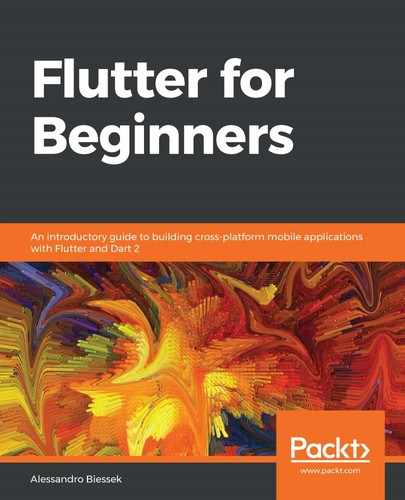Book Description
A step-by-step guide to learning Flutter and Dart 2 for creating Android and iOS mobile applications
Key Features
- Get up to speed with the basics of Dart programming and delve into Flutter development
- Understand native SDK and third-party libraries for building Android and iOS applications using Flutter
- Package and deploy your Flutter apps to achieve native-like performance
Book Description
Google Flutter is a cross-platform mobile platform that makes it easier to write secure and high-performance native apps for iOS and Android.
This book begins by introducing you to the Flutter framework and basics of Dart. You'll learn to set up the development environment to get started with your Flutter project. The book will guide you through designing the user interface and user input functions for your app. As you progress, you'll explore the navigator widget to manage your app routes and understand how to add transitions between screens. You'll then get to grips with developing your own plugin and discover how to structure good plugin code. The book will help you display a map from the Flutter app, add markers and interactions to it, and use the Google Places API. You'll build on your knowledge by not only adding tests to create a bug-free app, but also preparing it for deployment on Apple's App Store and Google Play. In later chapters, you'll learn to improve the user experience with advanced features such as map integrations, platform-specific code with native programming languages, and personalized animation options for designing intuitive UIs.
By the end of this book, you'll be well-versed with Dart programming and have the skills to develop your own mobile apps or build a career as a Dart and Flutter app developer.
What you will learn
- Understand the fundamentals of the Dart programming language
- Explore the core concepts of the Flutter UI and how it compiles for multiple platforms
- Develop Flutter plugins and widgets and understand how to structure good plugin code
- Style your apps with widgets and learn the difference between stateful and stateless widgets
- Add animation to your UI using Flutter's AnimatedBuilder component
- Integrate your native code into your Flutter codebase for native app performance
Who this book is for
This book is for developers looking to learn Google's revolutionary framework, Flutter from scratch. No knowledge of Flutter or Dart is required. However, basic programming language knowledge will be helpful.
Downloading the example code for this ebook: You can download the example code files for this ebook on GitHub at the following link: https://github.com/PacktPublishing/Flutter-for-Beginners. If you require support please email: [email protected]
